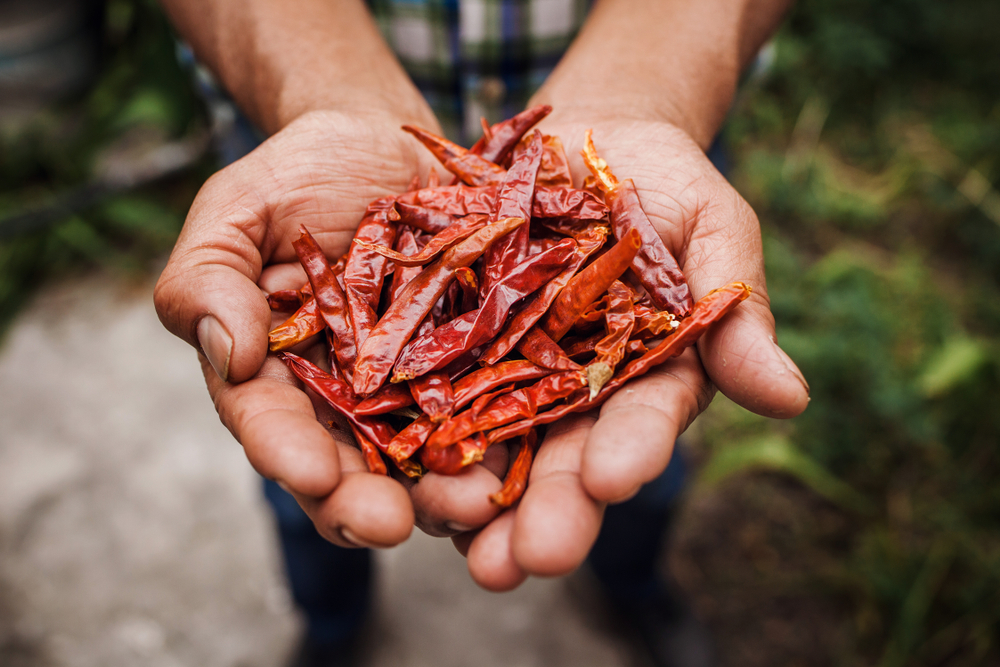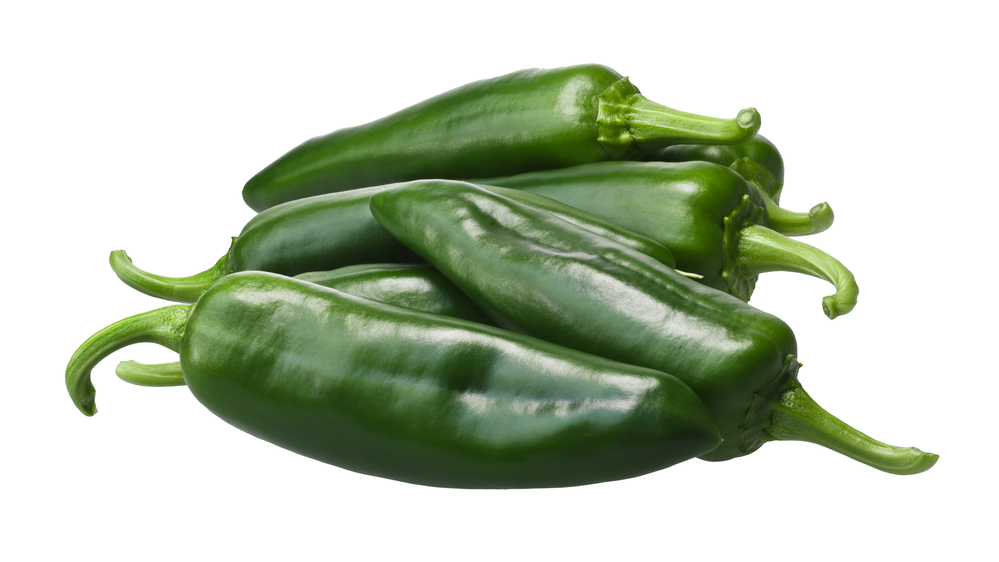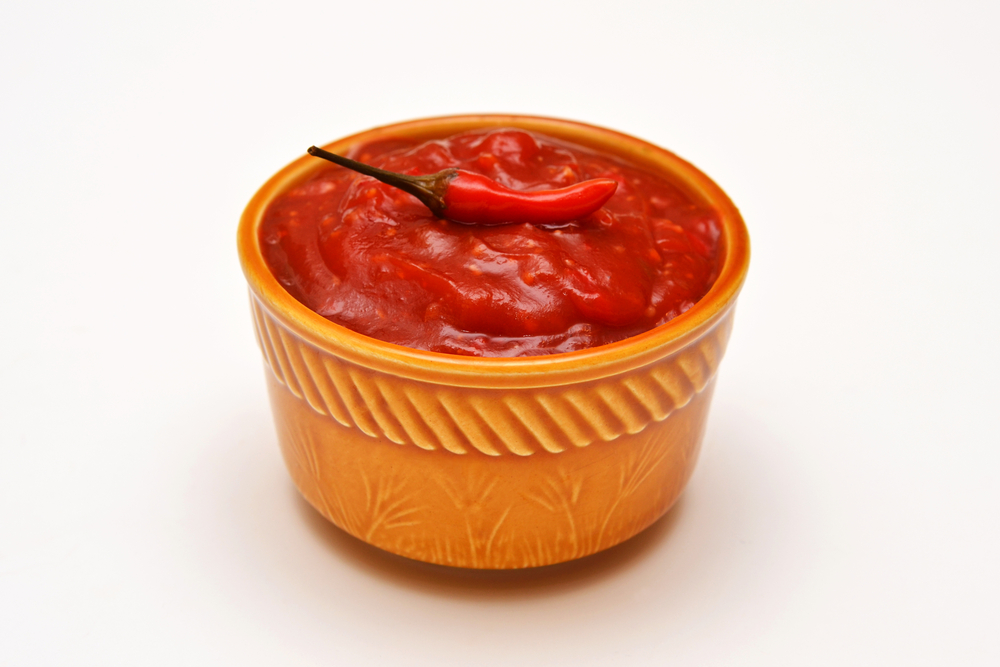As a lover of Mexican cuisine, I often find myself wondering about the differences between pasilla and poblano peppers. Both are staples in many dishes, but what sets them apart?
In this article, I will explore the key differences between these two peppers, from their appearance and flavor profile to their culinary uses and spiciness levels.
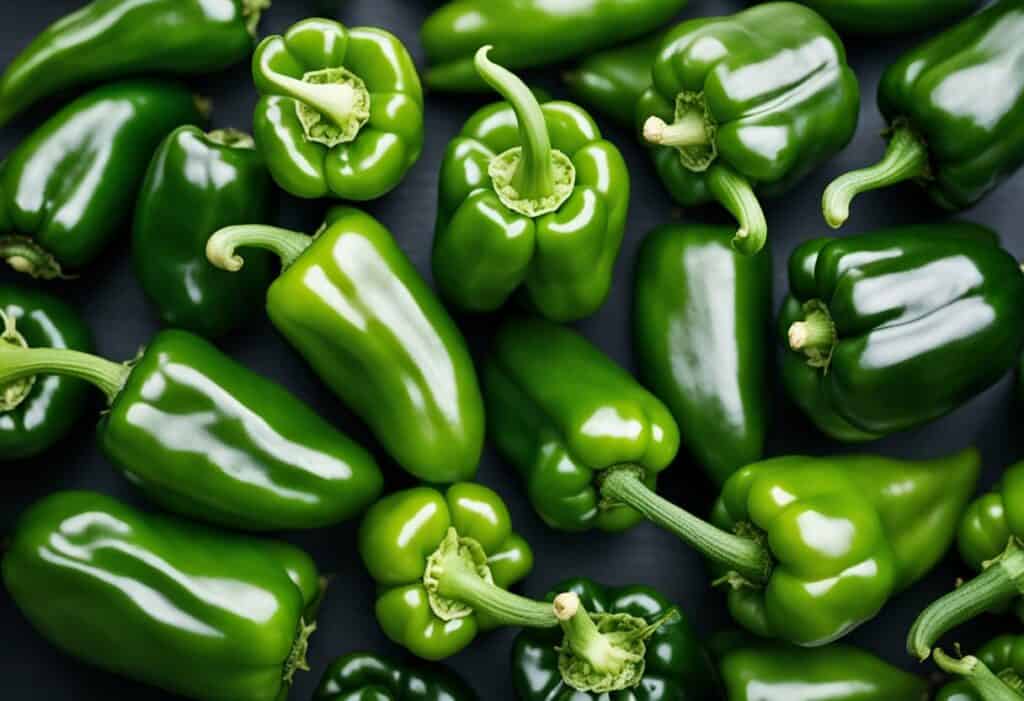
Understanding Pasilla Peppers Pasilla peppers are often used in Mexican cuisine, particularly in sauces and stews. They have a long, thin shape, with a dark green color when unripe and a deep brown color when fully matured.
Pasilla peppers have a smoky, earthy flavor profile, with notes of chocolate and raisins. They are typically mild in spiciness, with a Scoville heat range of 1,000 to 2,500 units.
Exploring Poblano Peppers Poblano peppers are larger and wider than pasilla peppers, with a heart-shaped appearance. They are commonly used in dishes such as chiles rellenos, where they are stuffed with cheese or meat and fried.
Poblano peppers have a milder flavor profile than pasilla peppers, with a slight sweetness and a hint of bitterness. They typically have a Scoville heat range of 1,000 to 2,000 units.
Key Takeaways
- Pasilla peppers are long and thin with a dark green to brown color, while poblano peppers are larger and heart-shaped.
- Pasilla peppers have a smoky, earthy flavor with mild spiciness, while poblano peppers have a milder flavor profile with a slight sweetness and bitterness.
- Pasilla peppers are often used in sauces and stews, while poblano peppers are commonly used in chiles rellenos.
Understanding Pasilla Peppers
As a Mexican cuisine enthusiast, I have come to appreciate the unique flavor and heat that pasilla peppers bring to dishes. Pasilla peppers are a type of dried chili pepper that is widely used in Mexican cuisine.
They are long and thin, and are usually dark brown in color. When dried, they are known as chile negro, which means “black chili” in Spanish.
Pasilla peppers are actually dried chilaca peppers, which are a type of mild to medium heat fresh pepper.
They are typically harvested when they are green and immature, but can also be harvested when they are ripe and red. They are then dried in the sun until they turn dark brown and have a little raisin-like texture.
Pasilla peppers are commonly used in sauces, especially mole, which is a complex sauce made with a variety of ingredients including dried peppers, nuts, seeds, and chocolate.
They are also used in stews, soups, and as a topping for tacos and other Mexican dishes.
In terms of heat, pasilla peppers are milder than jalapeño peppers, but hotter than bell peppers. They have a rich, smoky flavor with notes of chocolate, raisins, and tobacco.
The heat level can vary depending on the specific type of pasilla pepper, with the Pasilla Bajio being one of the hotter varieties.
In terms of size, pasilla peppers are generally longer and thinner than poblano peppers, which are another popular Mexican pepper.
While both pasilla and poblano peppers are often used in dried form, poblano peppers are also commonly used fresh in dishes like chiles rellenos.
Overall, pasilla peppers are a versatile and flavorful ingredient in Mexican cuisine. Whether used in sauces, stews, or as a topping for tacos, they add a unique smoky flavor and mild to medium heat that is sure to please any palate.
Exploring Poblano Peppers
Poblano peppers are a type of chili pepper that originates from Mexico. These peppers are typically green when unripe and turn a dark, reddish-brown color when fully ripe.
They are heart-shaped and have a mild, earthy flavor that makes them a popular ingredient in Mexican cuisine.
Poblano peppers are known for their versatility in cooking. They can be used in a variety of dishes, from soups and stews to chiles rellenos (stuffed peppers). They are also a great addition to salsas, sauces, and marinades.
One of the unique characteristics of poblano peppers is their size. They are bigger than other popular chili peppers like the Anaheim pepper, but smaller than bell peppers. This makes them a great option for stuffing with meats, cheeses, or other ingredients.
In terms of heat, poblano peppers are considered to be mild. They have a Scoville rating of 1,000 to 2,000, which is similar to the Anaheim pepper. This makes them a great option for those who want to add flavor to their dishes without too much heat.
Poblano peppers are often compared to ancho chiles, which are dried poblano peppers. Ancho chiles have a slightly sweeter flavor and are often used in mole sauces and other Mexican dishes.
Overall, poblano peppers are a great addition to any kitchen. They are versatile, mild, and have an earthy flavor that pairs well with a variety of ingredients.
If you’re looking for a fresh pepper to add to your next recipe, consider using poblano peppers.
Taste and Flavor Profile

When it comes to taste and flavor, Pasilla and Poblano peppers have a few key differences. Poblano peppers have a mild-to-medium heat and a smoky, earthy flavor with a bit of sweetness.
They are often used in Mexican cuisine to add flavor to dishes like Chiles Rellenos or Mole Poblano.
On the other hand, Pasilla peppers have a slightly spicier taste with a fruity undertone. They are often described as having an earthy flavor profile with hints of chocolate and raisins.
The dried Pasilla pepper has a more concentrated flavor than the fresh Poblano pepper.
Both peppers are commonly used in salsa, but the flavor profiles of the two peppers can greatly affect the taste of the salsa. Poblano peppers have a brighter, sweeter taste that pairs well with tomatoes and other fresh ingredients.
Pasilla peppers, on the other hand, have a deeper, earthier flavor that pairs well with smoky or roasted ingredients.
When it comes to spiciness, Pasilla peppers are slightly hotter than Poblano peppers, ranging from 1,000 to 2,000 on the Scoville scale compared to Poblano’s 1,000 Scoville units.
However, both peppers are considered relatively mild compared to other chili peppers commonly used in Mexican cuisine.
In summary, Poblano peppers have a smoky, earthy flavor with a bit of sweetness and are mild in spiciness. Pasilla peppers have an earthy flavor profile with hints of chocolate and raisins, a slightly spicier taste, and are also mild in spiciness.
The choice of which pepper to use in a dish will depend on the desired flavor profile and level of spiciness.
Heat and Spiciness
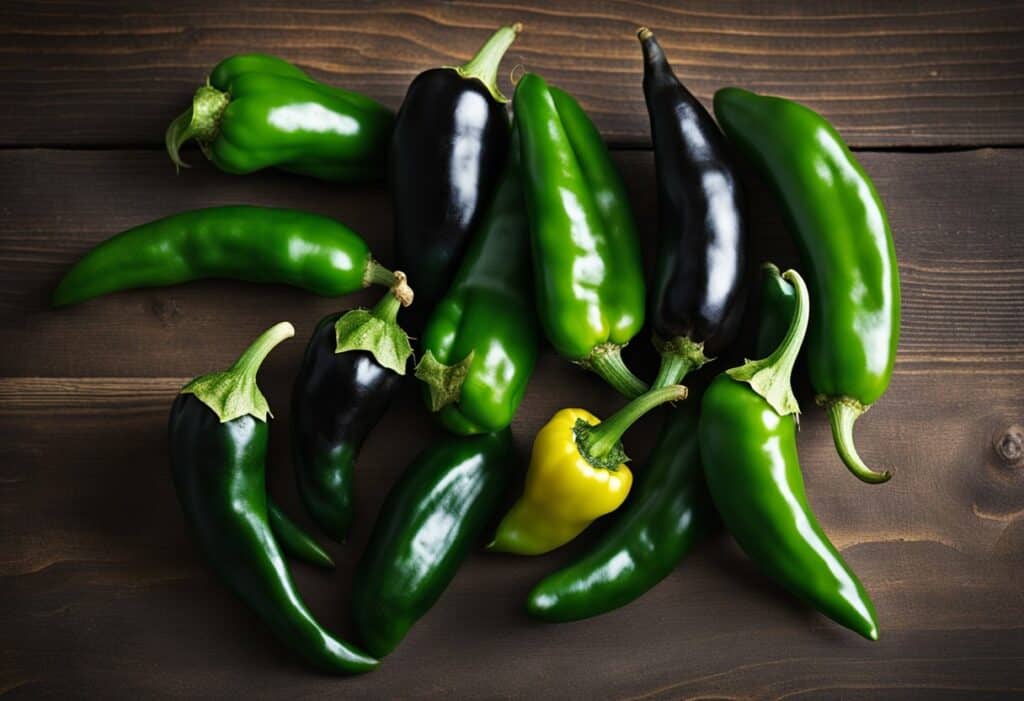
When it comes to heat and spiciness, there are some notable differences between pasilla and poblano peppers. Both are considered mild chilies, but pasilla peppers are slightly hotter than poblanos.
The Scoville scale is a measurement of the heat level of peppers. Poblano peppers have a Scoville heat unit (SHU) rating of 1,000 to 1,500, while pasilla peppers have a rating of 1,000 to 2,500 SHU.
This means that pasilla peppers are hotter than poblanos, but still considered mild in comparison to other chilies.
The heat level of both peppers can vary depending on factors such as growing conditions and ripeness. Generally, the heat of a pepper is concentrated in the seeds and membranes, so removing these can reduce the spiciness of the pepper.
In terms of flavor, both peppers have a slightly sweet and earthy taste. Pasilla peppers have a smoky flavor with notes of chocolate and raisins, while poblanos have a more herbaceous and grassy flavor.
Overall, if you are looking for a slightly spicier option, pasilla peppers may be the way to go. However, both peppers are mild enough to be used in a variety of dishes without overwhelming the palate.
Appearance and Texture
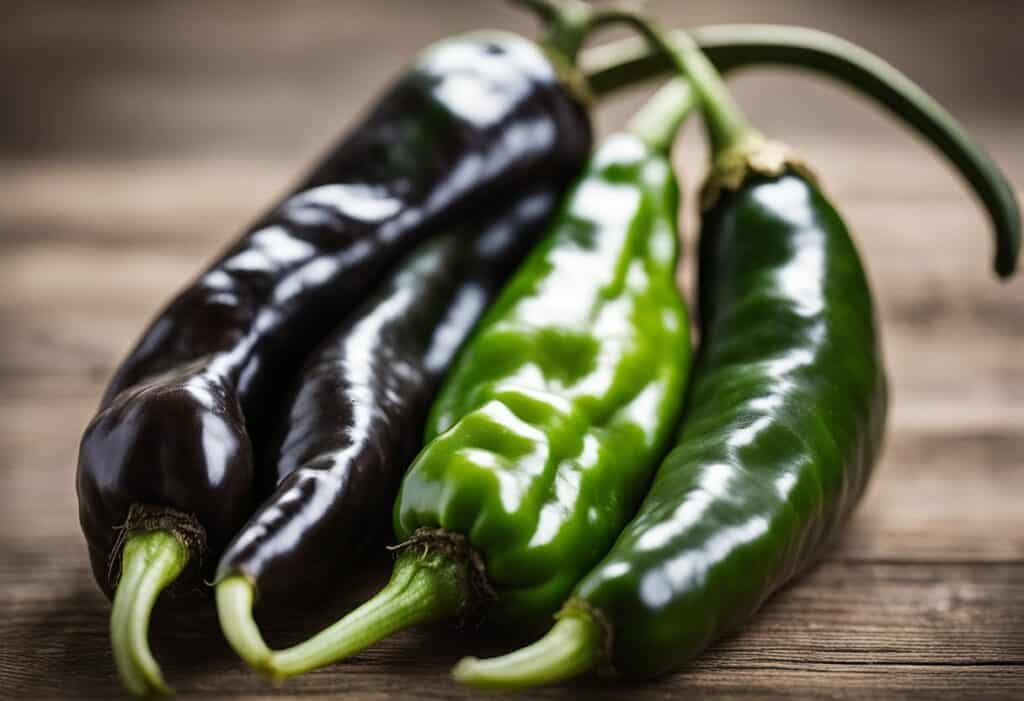
When it comes to appearance, Pasilla and Poblano peppers have some noticeable differences. Pasilla peppers are thin and long, measuring around 8 to 10 inches in length.
They have a dark brown to blackish color and a wrinkled texture. On the other hand, Poblano peppers are larger and wider, with a heart-shaped appearance. They are usually green in color and have a thick skin.
In terms of texture, Pasilla peppers are dry and brittle due to the drying process they undergo. They are usually sold in dried form and used in various Mexican dishes like mole sauce.
On the other hand, Poblano peppers are fresh and have a thinner skin, making them easier to roast and peel. They have a fleshy texture and are often used in stuffed pepper recipes.
It’s important to note that some people mistake Pasilla peppers for Ancho peppers, which are actually dried Poblano peppers. While both peppers have a similar appearance and flavor profile, they are not the same pepper.
Overall, the appearance and texture of Pasilla and Poblano peppers differ significantly. Pasilla peppers are thin, long, and dry, while Poblano peppers are larger, wider, and fresh.
Understanding these differences can help you choose the right pepper for your dish and avoid any confusion between the two.
Culinary Uses of Pasilla and Poblano Peppers
As a food enthusiast, I have experimented with both pasilla and poblano peppers in various dishes. These peppers have distinct flavors and heat levels that make them ideal for different culinary uses.
Cooking
Both pasilla and poblano peppers are versatile and can be cooked in various ways. They can be roasted, grilled, or fried. Roasting and grilling help to bring out their smoky flavors, while frying makes them crispy.
Sauces
Pasilla peppers are commonly used in Mexican sauces, such as mole sauce. Mole sauce is a complex sauce made with a variety of spices and ingredients, including pasilla peppers. On the other hand, poblano peppers are used in traditional Mexican green sauces, such as salsa verde.
Recipes
Pasilla peppers are commonly used in stews and soups, while poblano peppers are used in Mexican dishes such as chiles rellenos. Chiles rellenos are stuffed poblano peppers that are usually filled with cheese or meat.
Salsa and Pesto
Pasilla peppers are also used in salsa and pesto. Pasilla salsa has a rich, smoky flavor and is perfect for dipping tortilla chips or as a topping for tacos. Pasilla pesto is a great alternative to traditional basil pesto and is perfect for pasta dishes.
Grilled and Sandwiches
Poblano peppers are great for grilling and are often used in grilled dishes such as fajitas. They are also a perfect addition to sandwiches and salads, adding a nice crunch and mild heat.
Dressing and Marinades
Pasilla peppers can also be used in dressings and marinades. Pasilla dressing is perfect for salads and adds a rich, smoky flavor. Pasilla marinade is great for marinating meats, adding a complex flavor to the dish.
In conclusion, pasilla and poblano peppers are versatile and can be used in various culinary applications. Understanding their distinct flavors and heat levels can help you choose the right pepper for your dish.
Pasilla and Poblano in Mexican Cuisine
As two of the most popular peppers in Mexican cuisine, pasilla and poblano peppers are essential ingredients in many salsas, Mexican dishes, and moles. Although these peppers may look similar, they have distinct differences in terms of taste, heat, and texture.
Pasilla peppers are typically used in their dried form and have a deep, earthy flavor with hints of raisin and chocolate.
They are often used in mole sauce, a rich and complex sauce made with a blend of spices and chocolate. Pasilla peppers have a medium level of heat, ranging from 1,000 to 2,500 Scoville heat units (SHU).
Poblano peppers, on the other hand, are usually used fresh and have a mild, slightly sweet flavor.
They are often used in chiles rellenos, a dish where the peppers are stuffed with cheese and meat, battered, and fried. Poblano peppers have a low level of heat, ranging from 1,000 to 1,500 SHU.
Both pasilla and poblano peppers are part of the “holy trinity” of Mexican cuisine, along with ancho peppers. The combination of these three peppers is often used in many traditional Mexican dishes, such as tamales, enchiladas, and pozole.
In terms of texture, pasilla peppers are thin-skinned and have a wrinkled appearance, while poblano peppers are thicker-skinned and have a smoother appearance. Pasilla peppers are also longer and narrower than poblano peppers.
Overall, while both pasilla and poblano peppers are important ingredients in Mexican cuisine, they have distinct differences in terms of flavor, heat, and texture.
Understanding these differences can help you choose the right pepper for your dish and create authentic Mexican flavors.
Substitution Options

When it comes to substituting pasilla and poblano peppers, it’s important to keep in mind that both peppers have a unique flavor profile that can be hard to replicate. However, there are some options that can work well in a pinch.
One option is to use pasilla bajio peppers, which are very similar to pasilla peppers and can be found in many Mexican grocery stores. Anaheim peppers can also be used as a substitute for poblano peppers, as they have a similar mild flavor and heat level.
Guajillo peppers can also be used as a substitute for pasilla peppers, although they are slightly spicier. Anchos, on the other hand, are a little milder than pasilla peppers and can work well as a substitute in some dishes.
It’s important to keep in mind that when substituting peppers, the flavor profile of the dish may change slightly. However, with some experimentation, it’s possible to find a substitute that works well for your specific dish.
Overall, while pasilla and poblano peppers have a unique flavor that can be hard to replicate, there are some substitution options available that can work well in a pinch.
Availability and Usage
When it comes to availability, both pasilla and poblano peppers can be found in most grocery stores and supermarkets in the United States and Canada.
However, it’s important to note that there is sometimes confusion between the two, and they may be mislabeled or sold interchangeably.
In terms of usage, both peppers are versatile and can be used in a variety of dishes. Fresh pasilla peppers are often used in mole sauces and salsas, while fresh poblano peppers are commonly used in chiles rellenos. Both can also be roasted and used in soups, stews, and chili.
One key difference between the two peppers is their flavor profile. Pasilla peppers have a rich, smoky flavor with notes of chocolate, raisins, and tobacco, while poblano peppers have a milder, earthy flavor.
This makes pasilla peppers a great addition to dishes where a smoky flavor is desired, while poblano peppers are better suited for dishes where a more subtle flavor is preferred.
Another difference is their heat level. Pasilla peppers are generally hotter than poblano peppers, but still milder than jalapeño peppers. This makes them a good choice for those who want a little bit of heat in their dishes without it being too overpowering.
When it comes to using these peppers in recipes, there are a few things to keep in mind. Fresh pasilla peppers can be used in place of fresh poblano peppers in most recipes, but the reverse is not always true.
Roasted pasilla peppers can be used in place of roasted poblano peppers, but the flavor profile will be different. Pasilla peppers can also be used to make a flavorful pesto, while poblano peppers can be stuffed with cheese or other fillings for a delicious appetizer.
Overall, both pasilla and poblano peppers are great additions to any kitchen. Whether you’re looking to add some smoky flavor to your dishes or just a little bit of heat, these peppers are sure to please.
Differences Between Pasilla and Poblano Peppers
As a food lover, I have always been fascinated by the different types of peppers used in cooking. Two such peppers that often get compared are the Pasilla and Poblano peppers. While they may look similar, there are some key differences between the two.
Appearance
The first difference that you will notice between the Pasilla and Poblano peppers is their appearance. Pasilla peppers are longer and thinner, while Poblano peppers are wider and shorter.
Pasilla peppers are typically 4-6 inches long and around 1 inch wide, while Poblano peppers are usually 3-6 inches long and 2-3 inches wide.
Flavor
When it comes to flavor, both peppers have distinct tastes. Pasilla peppers have a rich, smoky flavor with a mild to medium heat level. They are less spicy than jalapeño peppers, but hotter than bell peppers.
The flavor is often described as earthy, with notes of chocolate, raisins, and tobacco. Poblano peppers, on the other hand, have a milder flavor with a slight sweetness. They have a heat level that is similar to a bell pepper, making them a great choice for those who don’t like spicy food.
Culinary Uses
Both Pasilla and Poblano peppers are commonly used in Mexican cuisine, but they are used in different ways. Pasilla peppers are typically used in sauces, soups, and stews. They are also used to make mole, a traditional Mexican sauce.
Poblano peppers, on the other hand, are often stuffed and baked. They are also used to make chiles rellenos, a popular Mexican dish.
Heat Level
When it comes to heat level, Pasilla peppers are hotter than Poblano peppers. Pasilla peppers have a heat level that ranges from 1,000 to 2,500 Scoville units, while Poblano peppers have a heat level that ranges from 1,000 to 1,500 Scoville units.
This makes Poblano peppers a good choice for those who want to add flavor to their dishes without adding too much heat.
In conclusion, while Pasilla and Poblano peppers may look similar, they have distinct differences in terms of appearance, flavor, culinary uses, and heat level.
Understanding these differences can help you choose the right pepper for your dish and take your cooking to the next level.
Related posts:
Frequently Asked Questions
What is the difference between pasilla and poblano peppers?
Pasilla and poblano peppers are two different types of peppers. Pasilla peppers are dried chilaca peppers, while poblano peppers are fresh chilaca peppers.
Pasilla peppers are thinner and longer than poblano peppers, and they have a wrinkled, dark brown skin. Poblano peppers, on the other hand, are wider and shorter than pasilla peppers, and they have a smooth, shiny skin.
What are pasilla peppers used for?
Pasilla peppers are commonly used in Mexican cuisine to add a smoky, rich flavor to dishes. They are often used in mole sauces, stews, and soups. Pasilla peppers can also be used to make salsa or to add flavor to marinades.
Can I use pasilla peppers for chile rellenos?
Yes, pasilla peppers can be used for chile rellenos, but they are not the traditional pepper used for this dish. Poblano peppers are the most commonly used pepper for chile rellenos.
What is hotter poblano or pasilla?
Poblano peppers are generally milder than pasilla peppers. Poblano peppers have a heat level of 1,000 to 1,500 Scoville heat units, while pasilla peppers have a heat level of 1,000 to 2,500 Scoville heat units.
How do you identify a poblano pepper?
Poblano peppers are wider and shorter than pasilla peppers, and they have a smooth, shiny skin. They are usually dark green in color and have a slightly curved shape. When ripe, they can turn red.
What is a good substitute for pasilla chiles?
Ancho chiles are a good substitute for pasilla chiles. They have a similar flavor profile and are also dried chilaca peppers. Another option is to use a combination of dried New Mexico chiles and dried guajillo chiles.



